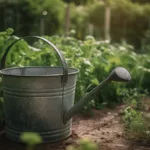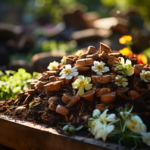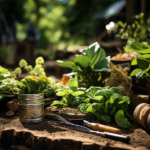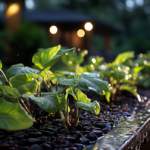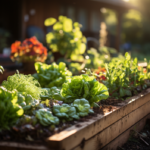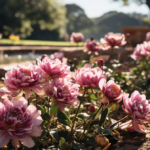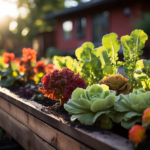Table of Contents
5 Simple Steps to Keep Your Flower Garden Blooming
Hey there, flower enthusiasts and green thumbs alike! Are you tired of your flower garden looking lackluster and dull? Well, fret no more because we’ve got you covered with our easy maintenance guide to keep your flower garden blooming all season long!
Maintaining a vibrant and thriving flower garden doesn’t have to be a daunting task. Just a little bit of TLC and a few simple steps are all it takes to transform your garden into a colorful oasis that will have your neighbors green with envy.
In this handy guide, we’ll walk you through the essential maintenance techniques that will ensure your flower garden stays in tip-top shape. From pruning and watering tips to soil preparation and fertilization, we’ve gathered all the tried-and-true methods that every successful gardener swears by.
Not only will we cover the basics, but we’ll also share some insider secrets and expert tricks to take your flower garden to the next level. We’ll explore the best practices for pest control, companion planting, and even provide recommendations for the most resilient and stunning flower varieties that are sure to thrive in your garden.
So, whether you’re a seasoned gardener or a complete novice, this easy maintenance guide will arm you with the knowledge and confidence needed to keep your flower garden blooming beautifully. Get ready to unleash your inner horticulturist and let’s dive into the world of flower gardening maintenance!
Pruning: The Key to Healthy and Abundant Blooms
Pruning is an essential aspect of flower garden maintenance that often gets overlooked. However, it is crucial in ensuring healthy and abundant blooms throughout the season. Here’s everything you need to know about the art of pruning your flower garden:
- Why Prune?
- When to Prune?
The timing of pruning depends on the type of flowers you have in your garden. In general, early spring is the best time to prune flowering shrubs and trees. This allows them to recover and produce new growth before the blooming period. However, some flowers, like roses, may require specific pruning techniques and timing. Research the specific requirements of your plant varieties and adjust your pruning schedule accordingly.
- Tools of the Trade
To prune effectively, you’ll need a few essential tools such as hand pruners, loppers, and a pruning saw for larger branches. Make sure your tools are clean and sharp to make precise cuts and avoid damaging the plants. It’s also a good idea to have a pair of gloves and protective eyewear to keep yourself safe during the process.
- Pruning Techniques
Start by removing any dead, damaged, or diseased branches, making clean cuts just above a healthy bud or lateral branch. For shaping and thinning, prune selectively to maintain the natural form of the plant. Always aim for an open center in shrubs and trees to promote airflow. Avoid pruning too much at once, as it may stress the plant. Instead, opt for regular maintenance pruning throughout the season.
Pruning encourages healthy growth, improves air circulation, and stimulates flower production. It helps remove dead or diseased branches, prevents overcrowding, and shapes the overall appearance of your plants. By pruning regularly, you’re essentially giving your flowers the best chance to thrive.
Remember, each flower variety may have specific pruning requirements. Take the time to research and understand the specific needs of your plants before you start pruning. With the right techniques and a little practice, pruning will become a breeze, and your flower garden will reward you with vibrant, healthy blooms all season long.
Watering Techniques for Optimal Flower Growth
Proper watering is a vital aspect of maintaining a blooming flower garden. Here are some essential techniques to keep your flowers well-hydrated and thriving:
- Know Your Plants’ Water Needs
- Water Deeply and Infrequently
Instead of frequently sprinkling your flowers with small amounts of water, it’s better to water deeply but less frequently. This encourages deep root growth, making your plants more resilient to drought conditions. Aim for watering 1-2 inches deep, ensuring the water reaches the root zone.
- Time Your Watering
The best time to water your flowers is early in the morning or late in the evening when temperatures are cooler. This allows the water to penetrate the soil effectively without evaporating too quickly. Avoid watering during the hottest part of the day, as the water may evaporate before reaching the roots.
- Use Mulch
Mulching around your flower beds can work wonders for water retention. Apply a layer of organic mulch, such as wood chips or straw, around your plants. This helps to conserve moisture in the soil, prevent weed growth, and regulate the soil temperature. Remember to leave a small gap around the plant stems to avoid moisture-related issues.
- Check Soil Moisture Levels
Regularly check the moisture levels of your soil before watering. Stick your finger about an inch into the soil; if it feels dry, it’s time to water. However, if it feels moist, hold off on watering to prevent over-saturation.
Different flower varieties have varying water requirements. Some prefer moist soil, while others can tolerate drier conditions. Research the specific needs of your plants to determine how often and how much to water them. Keep in mind that factors like sunlight exposure, soil type, and weather conditions will also affect watering frequency.
Remember, it’s better to underwater than to overwater your flower garden. Overwatering can lead to root rot and other issues. By following these watering techniques and understanding the needs of your plants, you’ll ensure healthy and vibrant blooms all season long. So grab your watering can or hose, and give your flowers the hydration they crave!
Preparing the Soil: Setting the Foundation for Success
Creating the right environment for your flower garden starts with preparing the soil. Good soil preparation is crucial for providing the necessary nutrients and support your flowers need to flourish. Here’s how to set the foundation for success:
- Clearing the Area
Start by clearing the designated area of your garden from any weeds, rocks, or debris. This allows your flowers to grow without competition for resources and prevents any potential damage to their roots.
- Loosening the Soil
Garden soil can become compacted over time, making it difficult for your flowers’ roots to penetrate and access nutrients. Use a garden fork or a tiller to loosen the soil, breaking up any clumps and improving its overall structure. This will also enhance water drainage and aeration.
- Adding Organic Matter
Incorporating organic matter into your soil is essential for enriching its fertility. You can use well-rotted compost, leaf mold, or aged manure to improve soil texture, increase moisture retention, and provide essential nutrients. Spread a layer of organic matter over the soil surface and mix it in thoroughly to a depth of 6-8 inches.
- Balancing the pH
Different flowers thrive in different soil pH levels. It’s important to test your soil’s pH and adjust it accordingly for optimal growth. Most flowers prefer a slightly acidic to neutral pH range. If your soil is too acidic, you can add lime to raise the pH, while sulfur can be added to lower it if it’s too alkaline.
- Amending with Nutrients
Along with organic matter, it’s beneficial to incorporate a balanced, slow-release fertilizer into the soil to provide your flowers with essential nutrients. Look for a fertilizer specifically formulated for flowering plants and follow the recommended application rates.
Remember, soil preparation is not a one-time task. It’s a continual process to ensure your flowers have a healthy and nutrient-rich environment to thrive in. By preparing the soil properly, you’re laying the groundwork for a vibrant and blooming flower garden that will bring you joy and beauty throughout the season. So get your hands dirty and set your garden up for success!
Fertilizing Tips to Nourish Your Flower Garden
Proper fertilization is key to providing the necessary nutrients for your flower garden to thrive. By following these fertilizing tips, you can ensure your flowers are well-nourished and ready to bloom their hearts out:
- Know Your Fertilizer
There are various types of fertilizers available, including granular, liquid, and organic options. Each has its benefits, so choose one that suits your preferences and the needs of your flowers. Look for a fertilizer with balanced NPK (nitrogen, phosphorus, and potassium) ratios, as these are vital for healthy growth and blooming.
- Timing Is Everything
Fertilizing at the right time is crucial. For most flowering plants, early spring is the ideal time to start fertilizing, as they require a nutritional boost for their growing season. However, be cautious not to fertilize too late in the season, as it may encourage new growth that won’t have enough time to harden off before winter.
- Follow Application Instructions
Read and follow the instructions on the fertilizer packaging carefully. Over-fertilizing can burn your plants, while under-fertilizing may result in lackluster blooms. Consider developing a fertilizing schedule and stick to it throughout the growing season, but remember to adjust based on the specific needs of your flowers.
- Apply Evenly and Water In
Spread the fertilizer evenly around the base of your flowers, avoiding direct contact with the foliage. Afterward, water the area thoroughly to ensure the nutrients are carried down to the root zone. This helps prevent potential burning and encourages proper absorption.
- Consider Organic Alternatives
If you prefer an organic approach, there are plenty of natural fertilizers to choose from. Compost, fish emulsion, bone meal, and seaweed extracts are excellent organic options. They provide slow-release nutrients and improve the soil structure over time.
Remember, fertilizing is just one aspect of maintaining a healthy flower garden. It should be combined with proper watering, soil preparation, and other maintenance practices. By following these fertilizing tips and tailoring them to the specific needs of your flowers, you’ll ensure they receive the nourishment required to produce abundant blooms that will dazzle your garden and bring you joy throughout the season. So, get ready to feed those flowers and watch them flourish!
Controlling Pests the Natural Way
Dealing with pests in your flower garden can be a real headache. But fear not! There are natural methods to keep those critters at bay without relying on harmful chemicals. Here are some essential tips for controlling pests the natural way:
- Identify the Pests
Before taking action, it’s essential to identify the pests wreaking havoc in your garden. Different pests require different solutions, so knowing what you’re dealing with will help you choose the most effective approach.
- Encourage Beneficial Insects
Rather than fighting against all insects, focus on attracting beneficial insects that naturally prey on garden pests. Ladybugs, lacewings, and praying mantises are excellent natural predators. Planting flowers like marigolds and daisies will help attract these helpful insects to your garden.
- Practice Crop Rotation
Crop rotation is a technique that involves changing the location of your plants each year to minimize pest infestations. Pests often target specific plant families, so rotating your flowers prevents them from building up populations in one area.
- Use Natural Repellents
There are various natural deterrents to keep pests away. Garlic and neem oil sprays can repel aphids and other soft-bodied insects. Sprinkling diatomaceous earth around plants can deter slugs and snails. A mixture of water and dish soap can also be effective against pests like whiteflies.
- Keep Your Garden Clean
Maintaining a tidy garden goes a long way in pest prevention. Remove dead leaves, weeds, and fallen fruits regularly. This eliminates hiding places and breeding grounds for pests. Additionally, remove any infected or infested plants immediately to prevent the spread of pests.
- Handpick Pests
For larger pests like caterpillars or beetles, handpicking can be an effective method. Wear gloves and remove the pests from the plants, dropping them into soapy water to drown them.
By implementing these natural pest control methods, you can protect your flower garden from unwanted visitors while maintaining a safe and healthy environment for your plants. Remember, a balanced ecosystem is the key to long-term pest management, so embrace these natural solutions and watch your garden flourish!
Companion Planting: Creating a Balanced Ecosystem
Companion planting is like having a secret weapon in your flower gardening arsenal. By strategically planting certain flowers together, you can create a balanced ecosystem that promotes healthy growth and reduces pest problems. Here’s how companion planting can work wonders for your flower garden:
- The Power of Combinations
Companion planting involves choosing flowers that work well together, benefiting each other in some way. Some plants have natural pest-repellent properties, while others attract beneficial insects or improve soil fertility. Combining them creates a harmonious environment for your flowers to thrive.
- Repel and Confuse Pests
Certain flowers have natural pest-repellent properties. For example, marigolds emit a scent that deters aphids and nematodes, while lavender repels moths and mosquitoes. Placing these flowers near vulnerable plants acts as a natural defense mechanism, keeping pests at bay.
- Attract Beneficial Insects
Just as some flowers repel pests, others attract beneficial insects. Planting flowers like cosmos, yarrow, and alyssum attracts ladybugs, lacewings, and bees, which feast on garden pests like aphids and caterpillars. These beneficial insects become your garden’s allies in pest control.
- Nurturing Soil Health
Certain plants have deep root systems that help loosen compacted soil, improving its structure and enhancing water drainage. For example, planting sunflowers alongside your flowers can help break up heavy soil. Leguminous flowers like clover and lupines fix nitrogen in the soil, enriching it naturally.
- Beneficial Plant Combinations
Some flower combinations are particularly beneficial. For instance, planting roses with garlic or chives can deter aphids. Pairing tomatoes with basil not only enhances their flavor but also repels pests. Research different flower combinations and experiment to find the best matches for your garden.
Companion planting is a natural and holistic approach to flower gardening. By carefully choosing flower combinations, you can create a thriving ecosystem that reduces pest problems, improves soil health, and enhances the overall beauty of your garden. Embrace the power of companion planting and watch your flowers bloom to their fullest potential!
Choosing Resilient Flower Varieties for Your Garden
When it comes to keeping your flower garden blooming, selecting the right varieties can make all the difference. Opting for resilient flowers that can withstand various conditions and thrive with minimal fuss is a smart choice. Here are some essential tips for choosing resilient flower varieties for your garden:
- Consider Climate Conditions
Evaluate the climate in your region, including temperature, humidity, and average rainfall. Look for flower varieties that are known to thrive in your specific climate conditions. Native plants or those adapted to your region often have natural resilience and require less maintenance.
- Research Disease Resistance
Check for flower varieties that are resistant to common diseases prevalent in your area. Some flowers are naturally resistant to fungal infections, while others have built-in defenses against pests. Research specific flower varieties and choose ones with a track record of disease resilience.
- Look for Drought Tolerance
If you live in an area with water restrictions or frequently experience dry spells, choosing flowers that are drought-tolerant can save you a lot of hassle. Look for varieties like lavender, sedum, or yarrow, which have adapted to survive in arid conditions.
- Consider Wildlife Attraction
Certain flowers are not only resilient but also attract pollinators and wildlife. Incorporating these varieties in your garden can contribute to a thriving ecosystem. Flowers like coneflowers, sunflowers, and bee balm are known to attract bees, butterflies, and birds, enhancing the ecological diversity of your garden.
- Pay Attention to Maintenance Requirements
Read up on the maintenance needs of different flower varieties. Some may require frequent deadheading, while others need minimal pruning or are self-seeding. Choose flowers that align with your desired level of maintenance commitment, ensuring that they fit well with your lifestyle and gardening habits.
Choosing resilient flower varieties sets the foundation for an easy-to-maintain and flourishing garden. By selecting flowers that can withstand your climate, resist diseases, tolerate drought conditions, attract wildlife, and align with your maintenance preferences, you’ll be well on your way to a stunning and low-maintenance flower garden that brings you joy all season long. So, take your time, do your research, and choose the best resilient flowers for your garden!
Conclusion
And there you have it, fellow gardeners! With the easy maintenance guide we’ve covered, you now have all the tools and knowledge to keep your flower garden blooming beautifully. From pruning and watering techniques to soil preparation, pest control, and choosing resilient flower varieties, we’ve touched on all the essential aspects to ensure your garden thrives.
Remember, maintaining a vibrant flower garden doesn’t have to be a daunting task. By incorporating these simple steps into your gardening routine, you’ll create an environment where your flowers can thrive and bring joy to your outdoor space.
So go ahead, get your hands dirty, and put these tips into practice. Enjoy the therapeutic experience of nurturing your plants and watching them blossom into a colorful paradise. Take pride in your garden, knowing that with a little bit of effort and care, you’ve created a haven for nature’s beauty.
Whether you’re an experienced gardener or just starting out, this easy maintenance guide will be your go-to resource throughout the gardening season. So grab your tools, put on your gardening gloves, and let’s keep those flower gardens blooming! Happy gardening!


